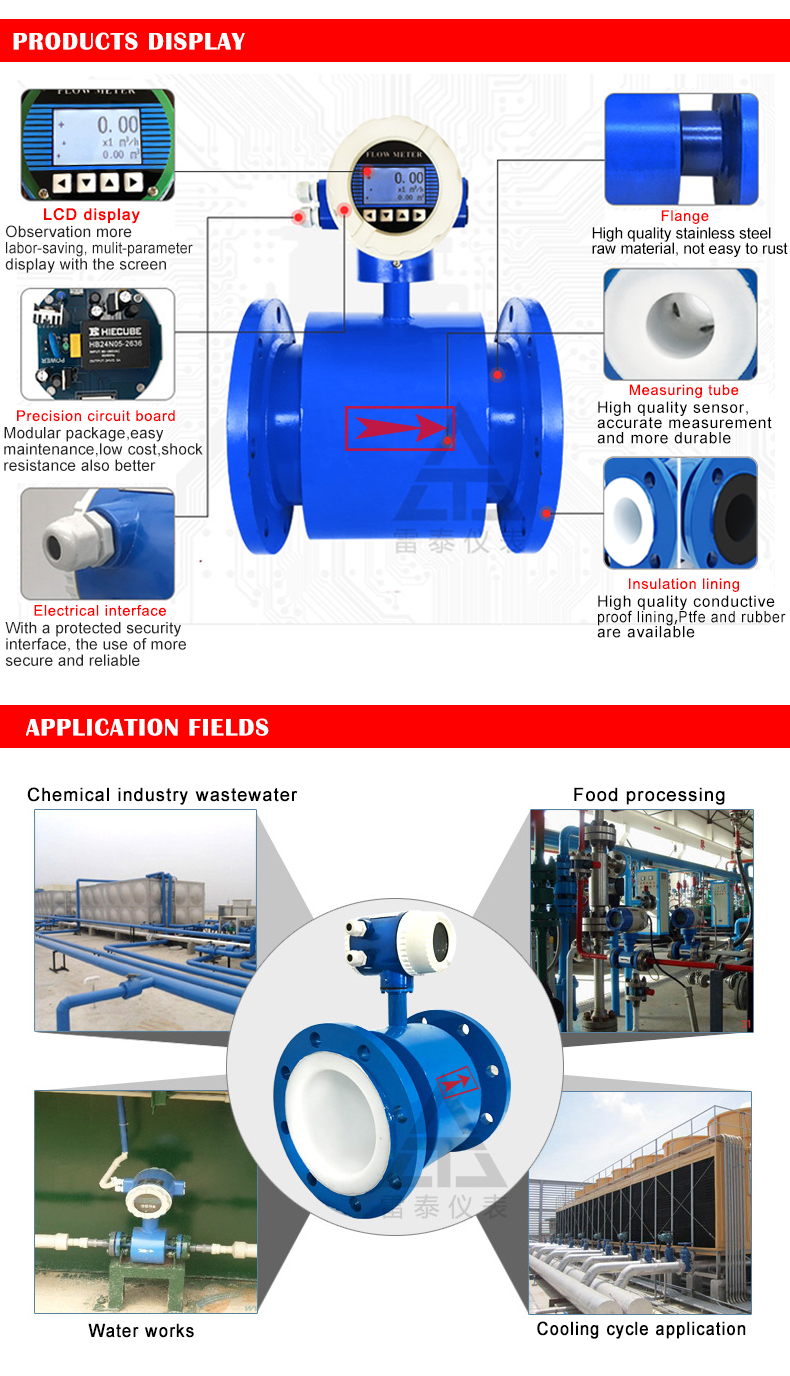1. Working principle
Based on Faraday's law of electromagnetic induction, the conductive medium inside the measuring tube is equivalent to a conductive metal rod in Faraday's experiment, and the electromagnetic coils at the upper and lower ends generate a constant magnetic field. When a conductive medium flows through, an induced voltage is generated, and the two electrodes inside the pipeline measure this induced voltage. The induced voltage E=KBVD, where K is the instrument constant, B is the magnetic induction intensity, V is the average flow velocity inside the measuring pipe surface, and D is the diameter of the flow meter. By detecting and processing the induced voltage, instantaneous flow rate and cumulative flow rate data are obtained and displayed.
2. Characteristics
① High measurement accuracy: It is not affected by changes in fluid density, viscosity, temperature, pressure, and conductivity, and can achieve high-precision measurement. Generally, the accuracy can reach levels 0.5 and 1.0.
② Wide measurement range: It can measure various liquid and liquid-solid two-phase fluids with conductivity greater than 5 μ S/cm, including sewage, acidic and alkaline liquids, mud, slurry, etc.
③ Small pressure loss: There are no obstructed flow components inside the measuring tube, and there is no pressure loss or fluid blockage, making it energy-saving and efficient.
④ Fast response speed: No mechanical inertia, fast response, good stability, can be applied to automatic detection, adjustment, and program control systems.
⑤ Strong anti-interference ability: using microcontroller embedded technology, digital excitation, etc., some also use CAN fieldbus, etc., it has strong anti-interference ability and can work stably in complex electromagnetic environments.
⑥ Rich intelligent functions: equipped with self diagnostic function, able to automatically detect faults and issue alarm signals; Real time traffic, cumulative traffic, and other information can be easily read through the display screen, and multiple communication methods can be supported to facilitate data transmission and interaction with other devices.
3. Application Fields
① Industrial production: used in industries such as chemical, pharmaceutical, food, paper, etc. for flow monitoring and control in the production process, ensuring the stability of the production process and consistency of product quality.
② Water conservancy engineering: can be used to measure the flow of water bodies such as rivers and channels, providing a basis for water resource management and scheduling, and can also be used for flow monitoring of hydropower stations.
③ Environmental monitoring: used to measure the flow of air pollutants, wastewater, etc., providing data support for environmental monitoring and treatment.
④Oil and gas industry: used to measure the flow rate of fluids such as crude oil and natural gas in pipelines, providing important data support for energy production and transportation.
Electromagnetic flowmeter is a commonly used flow measurement instrument, which has the following significant characteristics:
1.High measurement accuracy: Using the principle of electromagnetic induction, it is not affected by changes in physical parameters such as temperature, pressure, density, viscosity, etc. of the fluid, and can provide high-precision measurement results. The general accuracy can reach ± 0.5% - ± 1.0%, or even higher.
2.Wide measurement range: It can measure fluids with various flow ranges, from small to large flow rates, and can accurately measure them. The range ratio can usually reach 100:1 or even wider, which can adapt to the flow measurement needs of various industrial occasions.
3.Non contact measurement: The sensor does not directly contact the measured fluid, which does not interfere with the flow state of the fluid, nor is it affected by impurities, particles, etc. in the fluid. At the same time, it avoids wear and corrosion problems, prolongs the service life of the equipment, and is particularly suitable for measuring fluids containing solid particles, fibers, or highly corrosive substances.
4.Bidirectional measurement: capable of measuring both forward and reverse fluid flow rates. For some pipeline systems where bidirectional fluid flow may occur, there is no need to install additional reverse measurement devices, which facilitates flow monitoring and management.
5.High reliability: Without mechanical moving parts, there are no faults caused by mechanical wear and tear, and it has high reliability and stability. After rigorous quality testing and long-term practical verification, it can operate continuously and stably in harsh industrial environments.
6.Easy installation and maintenance: The requirements for the straight pipe section during installation are relatively low, usually 5-10 times the diameter of the upstream straight pipe section and 3-5 times the diameter of the downstream straight pipe section. Moreover, the structure is simple and the maintenance workload is small. Regular maintenance mainly checks whether the sensor electrodes are dirty, worn, etc., making cleaning and replacement more convenient.
7.Strong intelligent functionality: It has multiple intelligent functions, such as remote data transmission, real-time monitoring, and fault self diagnosis. Measurement data can be transmitted to a remote control center through a communication interface, making it convenient for operators to grasp real-time flow information, discover and solve potential problems in a timely manner, and improve the automation level and management efficiency of the production process.
8.Good compatibility with fluids: It can measure various conductive liquids, including acid, alkali, salt solutions, and slurries containing suspended particles. It has a wide range of applications and is widely used in many industries such as chemical, metallurgical, power, and water treatment.
We specialize in producing electromagnetic flowmeter, vortex street flowmeter, spiral vortex flowmeter, turbine flowmeter, liquid gas mass flow meter, metal tube rotameter, orifice flowlmeter, ultrasonic flowmeter, verabar flowmeter, target type flowmeter, magnetic level indicator, differential pressure transmitter, etc.






